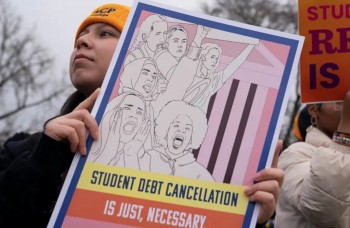Student Loan Reform in America: Your College Costs and Debt Future
 Not to Pay 'Student Loans' for 2 Years, Get Forgiveness After 10 Years Not to Pay 'Student Loans' for 2 Years, Get Forgiveness After 10 Years |
 Joe Biden Cancels Student Debt: What Happens Next Joe Biden Cancels Student Debt: What Happens Next |
 |
| Plan to overhaul the country’s student loan and financial aid system |
Aimed at curbing student debt growth and reducing taxpayer exposure, the proposal introduces major changes to borrowing limits, repayment options, loan forgiveness programs, Pell Grant eligibility, and college accountability standards.
Why This Student Loan Reform Matters
The U.S. federal student loan system serves over 43 million borrowers and underwrites more than $1.7 trillion in outstanding debt. With college costs rising and loan repayment programs under growing scrutiny, the GOP's plan marks the most significant effort to overhaul the system in over a decade.
Key Changes Proposed in the Republican Plan
1. New Federal Loan Limits for Students
One of the plan’s most consequential moves is capping federal borrowing, which will reduce how much students can take out — and potentially limit college access for some.
-
Undergraduate limit: $50,000 total
-
Graduate student limit: $100,000 total
-
Start date: July 1, 2026
Current loan limits vary by year and dependency status; many students can currently borrow significantly more.
Impact:
Students attending high-cost institutions or pursuing graduate/professional degrees may have to seek private loans, which typically lack income-based repayment, deferment options, and loan forgiveness protections.
2. Reduction in Repayment Options and Protections
The Republican proposal aims to simplify and shrink the number of repayment plans — but it also removes key safety nets.
-
Replaces multiple Income-Driven Repayment (IDR) plans with a single streamlined plan
-
Eliminates economic hardship deferment and unemployment deferment for loans disbursed after July 2025
-
Replaces long-term loan forgiveness options with standard fixed-term repayment only
Impact:
This reduces flexibility for borrowers facing job loss or low wages and removes the popular Public Service Loan Forgiveness (PSLF) program, which has helped thousands of government and nonprofit employees manage debt.
3. Major Pell Grant Eligibility Overhaul
The plan changes how students qualify for Pell Grants, which are critical to low-income undergraduates.
-
New minimum enrollment requirement: 30 academic hours per year (roughly 15 credits/semester)
-
Expanded Pell access for short-term training programs that meet outcome standards
-
Maximum Pell award for 2025–2026: $7,395
Impact:
While expansion into workforce training is welcomed by career-readiness advocates, critics argue that raising the threshold could exclude part-time students, many of whom work full-time or care for dependents.
4. Elimination of Loan Forgiveness Programs
The GOP plan would phase out most federal forgiveness options, including:
-
Public Service Loan Forgiveness (PSLF)
-
Income-based loan forgiveness after 10–20 years
Borrowers would repay their loans in full over a fixed period, with no remaining balance cancellation.
Impact:
The loss of these programs hits hardest for teachers, nurses, military personnel, and nonprofit workers, many of whom rely on PSLF to make education affordable on modest incomes.
5. College Accountability Through “Risk Sharing”
A central feature of the plan is a risk-sharing model where colleges would be financially liable if graduates default at high rates or earn too little to repay loans.
-
Institutions would have to repay a portion of federal loan balances if outcomes fall short
-
Schools would be required to publish detailed program-level data: graduate earnings, debt levels, and default rates
Impact:
This could drive institutions to cut low-performing programs, raise admission standards, or shift focus to majors with higher economic returns — potentially disadvantaging students in the arts, humanities, or social work.
6. Expansion of Workforce and Career-Focused Education
The GOP proposal places significant emphasis on non-traditional educational pathways, such as:
-
Trade schools
-
Apprenticeships
-
Short-term certification programs
Pell Grants would now be allowed for programs under 15 weeks, as long as they deliver verified employment outcomes.
Impact:
This aligns with Republican goals to diversify postsecondary education and reduce reliance on four-year degrees, particularly in fields where credentials or technical skills may be more cost-effective.
Political and Public Response
The reaction to the plan has been deeply polarized.
Supporters say:
-
It is a fiscally responsible approach to an out-of-control lending system.
-
It will force colleges to deliver value or face consequences.
-
It redirects funding toward job-ready training, not bloated degrees.
“We must break the cycle of unlimited government lending propping up overpriced degrees,” said Rep. Virginia Foxx (R-NC), chair of the House Education Committee.
Critics argue:
-
It will limit college access, particularly for low-income, working-class, and minority students.
-
It removes essential borrower protections during economic downturns.
-
It favors for-profit institutions and short-term programs over comprehensive education.
“This plan punishes students while letting for-profit colleges off the hook,” said Rep. Bobby Scott (D-VA), ranking Democrat on the committee.
What’s Next?
The proposal heads into a divided Congress, where bipartisan support is uncertain. Some elements — like workforce investment — may gain traction. Others — such as eliminating forgiveness — will face resistance from Democrats and borrower advocates.
Timeline to Watch:
-
Debate in the House: Summer 2025
-
Senate response: Fall 2025
-
Potential changes effective by: July 2026
With the 2026 midterm elections looming, student debt policy will remain a high-stakes issue that could shape not only education policy but voter sentiment across generations.
Final Takeaway
The Student Success and Taxpayer Savings Plan represents a dramatic ideological shift in how federal student loans are viewed — from a public investment in higher education to a contractual obligation based on return on investment.
For students, families, and institutions alike, the message is clear: the era of unlimited borrowing and expansive forgiveness is ending — and a new model built on accountability, limits, and employment outcomes is taking its place.























